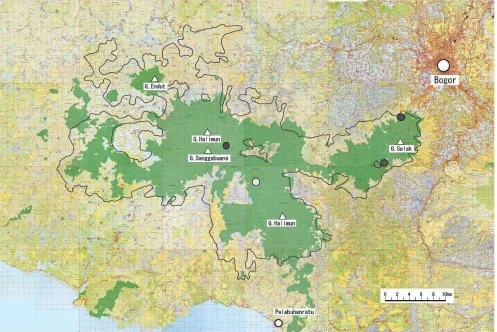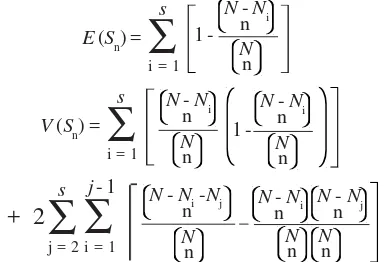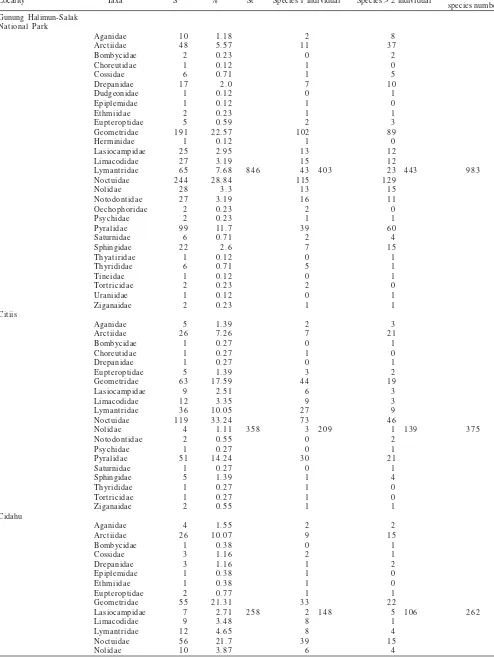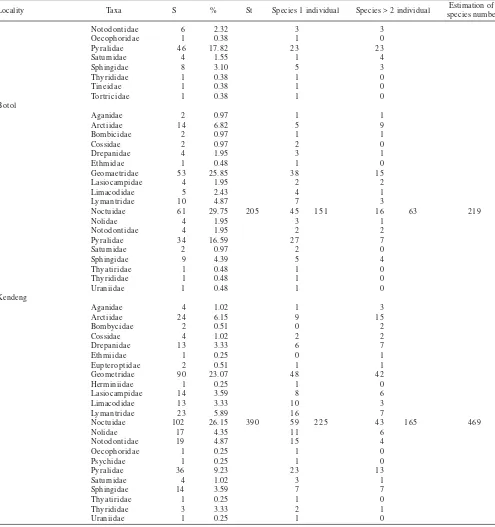ISSN: 1978-3019
Moth Diversity at Gunung Halimun-Salak National Park, West Java
HARI SUTRISNO
Laboratory of Entomology, Zoology Division, Research Center for Biology, Jalan Raya Bogor Km. 46, Cibinong 16911, Indonesia
Phone: +62-21-8765056; Fax: +62-21-8765068; E-mail: [email protected], [email protected]
Received March 27, 2008/Accepted September 29, 2008
A study on moth fauna with focus on macro-moths was conducted at Gunung Halimun-Salak National Park from January to December 2007. The aims of the study were to acquire information of macro-moth diversity and to access the composition of the species at this area. Another objective of the research was to explore undescribed species of moths that inhabit this park. The result showed that a year collecting time with four sampling sites recorded only about 86% of estimated value in this park (846 of 983 species). Index diversity based on Fisher’s á is high. In addition, the number of families recorded from this park is also high, 29 families, or about half of the moth families that occur in Indo-Malayan region. Citiis site was the highest among other sites in term of the diversity index, while Gunung Botol is the lowest. These two sites have a few species in common. In general, Geometridae, Noctuidae, and Pyralidae dominate across all sites. The other significant finding of the research is that Dudgeonidae that has never been recorded from Indonesia was found at Citiis site.
Key words: diversity, macro-moths, similarity
___________________________________________________________________________
INTRODUCTION
It is well known that Lepidoptera, moths and butterflies, is the most divers group among insects after Coleoptera and Hymenoptera. It has been estimated that the number of Lepidoptera is more than 160,000 species and more than 90% of them is moths. The adults of Lepidoptera have an important role in the forest ecosystem as a pollinator. Their larvae are mainly as plant defoliators, but there are also leaf miners (several micro-lepidoptera families such as Nepticulidae and Grascillaridae), stem borers (for instances in Noctuidae and Pyralidae), flower feeders (Noctuidae and Geometridae), and timber borers (Cossidae and Hepialidae). The larvae indeed often show a great specifity to host plants (Holloway 1976, 1984; Hebert 1980; Heppner 1989).
Compared with butterflies, however, our knowledge on moth fauna in Indonesia are still very limited and poorly documented. Researches on moths have mostly focused on biological aspects of certain groups of economic value: i.e. agricultural pests. This is partly because the Indonesian moth fauna has a high proportion of very small body size species (microlepidoptera). Although, there have been some efforts to inventory our moth faunas such as study on diversity of Lepidoptera in the Gunung Halimun National Park (Atmowidi et al. 2001). However, because of lack adequate capacity to identify to species taxa, they failed to achieve the objective of the research. Studies conducted by Sutrisno (2005, 2007) in peat swamp forest of Sebangau National Park and Nusa Barong Nature Reserve (East Java) showed only small portion of moth diversity which might be far from the actual number of species in those areas since this work was conducted during a short period. Other studies, mostly focused on certain groups of moths in Sumatra have been carried out by Germany researchers and published in a series book of Heterocera Sumatrana. Holloway et al. (1987) and Holloway (1993) studied
in Sulawesi and Seram Island with focused on macrolepidoptera. Therefore, all these efforts are still needed to be continued to cover all Indonesian moth. In order to acquire information of Indonesian moth diversity, I am conducting a study at Gunung Halimun-Salak National Park, West Java for a year (2007).
There are almost 80 species of butterflies inhabit this national park, but there is no information for the moth diversity in this area even though this park holds the largest remaining lowland and montane tropical rain forest in the whole of Java (Kahono & Amir 2003). I suspect that there are many undescribed species of moths inhabit this area. Therefore study on moths in this national park is needed. The aims of the study were to acquire information of the moth diversity and to assess the composition of moth species at Gunung Halimun-Salak National Park.
MATERIALS AND METHODS
Collecting of Adult Moths. Sampling was conducted using light traps equipped with a 160 watt mercury vapor light and a 2 x 2.5 m white screen. The light trap was set up randomly at the open area within the National Park. Moths attracted to the light trap and lied at the white screen were collected into an ethyl acetate-killing bottle. For the large moths (wing span > 5 cm) were collected by using an insect net and then injected at the thorax with a small amount of absolute ammonia. All specimens collected at the night and then were pined using insect pins no. 3 and 4 at the next morning, while the specimens are still in fresh condition.
Specimen Preservation. Preservation of the specimens was conducted at the laboratory of Entomology, Division of Zoology, Research Center for Biology, Cibinong. All moth specimens were labeled based on the field collection data. Their wings were spread and then dried up using oven at 45-50 oC for 3-5 days, depends on the condition of specimens.
Species identification was based on Common (1990); Lane and Lane (2006); Holloway et al. (2001). All the materials were deposited at the Museum of Zoologicum Bogoriense, the Indonesian Institute of Sciences, Cibinong.
Sites of Study. To generate more comprehensive results, monthly samplings were conducted during a year (2007). Four sites of sampling were chosen, namely Citiis, Cidahu, Pasir Banteng (Gunung Botol), and Cikaniki (Gunung Kendeng). The range location of four sites was 106°21’-106°38’E - 6°37-6°51’S. The two first sites are located at Gunung Salak, while the two last sites at Gunung Halimun (Figure 1).
Citiis. This site is the closest from Bogor, around 45 km from Bogor at altitude of approximately 600 m asl. As a secondary forest, the vegetation at this site is mixed between vegetation of Collline zone with the monoculture of the timber plantation and the traditional farming area. In this site, the researches of moth were conducted on February, April, June, July, and November 2007.
Cidahu. This site is located around 70 km from Bogor at altitude 900 m asl. Vegetation of this site is dominated by
Fagaceae (Castanea spp.). In this site, the researches of moth were conducted on January, March, and December 2007.
Pasir Banteng (Gunung Botol). This site is located at altitude of approximately 1,500 m asl, around 10 km from the Cikaniki Research Station. This area is classified as montane zone and the vegetation dominated by Fagaceae (Castanopsis spp., Lithocarpus spp., and Quercus spp.).
In this site, the researches of moth were conducted on May and August 2007.
Cikaniki (Gunung Kendeng). This site was near the Cikaniki Research Station at altitude of approximately 950 m asl and classified as ‘Colline Primary forest Zone’. The vegetation is dominated by Altingia exelsa. In this site, the researches of moth were conducted on September and October 2007.
Data Analysis. Measuring the diversity for species-richness was based on á–statistic of Fisher (Fisher et al. 1943). Fisher’s alpha diversity index, defined implicitly by the formula:
S=a ln(1+n/a)
where S: number of taxa, n: number of individuals, and a: is the Fisher’s alpha.
Justification for this on grounds of the frequent approximation of light-trap moth samples to a log-series distribution of abundance among the species is given by Taylor et al. (1976) and, within a South East Asian context is given by Barlow and Woiwod (1989). Wolda (1983) demonstrated that this statistic was the most sample-size
independent of a number of frequently used of diversity measure. For comparison among four sites, Jaccard index of similarity is used. This is a robust measure of beta diversity and widely used in a biodiversity research.
In addition, I have chosen an extrapolation method, which given an estimate of the total number species from empirical samples. N: the total number of individuals in the sample, s: the total number of species, and Ni: the number of individuals of species i. The expected number of species E(Sn) in a sample of size n and the variance V(Sn) are then given:
All this methods were implemented in “methodological ecology” software (Krebs 1998).
The Value of Light Collecting. A correct statistical analysis first requires a certain number of replicate samples, which, secondly, have to be drawn randomly. Both conditions are not met in the present study. They are hardly achievable in these kinds of studies at all, because the use of light or light trap is a selective method and the number of replicate usually remains low. Nonetheless, the use of light in collecting Lepidoptera yields the highest proportion of the total species spectrum at a given locality. It is nearly impossible to get similar part of taxocenosis by applying other methods.
RESULTS
Therecordof species collected of the study is available on request and all specimens were deposited at Museum of Zoologicum Bogoriense.These results in Table 1 showed that the short collecting time spent across all sites in this park makes the results only a fragment of the actual existing Lepidoptera fauna which is only 846 of 983 species or about 86%. In addition, the number of families recorded from this park was quiet high, 29 families, about half on the families of moth that occur in Indo-Malayan region.
Family Noctuidae, Geometridae and Pyralidae were dominant among other families in this park, they were 244 species (28.84%), 191 species (22.5%), and 99 species (11.7%), respectively. It was not surprising since the same phenomenon has been repeatedly reported by numerous researchers. The number of species with more than two individuals was slightly higher than the number of species with 1 individual, they were 443 (52.36%) and 403 (47.63%).
Table 1 also showed the species number of each family, their abundant and the estimated species on each site in this park. Compare to other sites, Gunung Botol has the lowest
number, only 205 species were recorded from 19 families, while Gunung Kendeng has the highest number with total species were 390 from 23 families. The remarkable differences between observed and estimated values demonstrate that a considerable part of the local fauna remained uncollected. In Citiis, Cidahu, and Gunung Botol, fauna which has been recorded varies from 93.6 to 98.47% but from Gunung Kendeng only about 83.1% of estimated value. In addition, family Noctuidae was the most dominant among other families followed by family Geometridae and Pyralidae. However, at Cidahu site the percentages of the two families, Geometridae and Noctuidae were almost similar, 21.31 and 21.70%.
Table 2 showed the similarity index of macro-moths fauna based on Jaccard’s index for a binary comparison. The values of similarity index based on Jaccard’s for all pairwise comparisons were very low. The highest value was obtained by comparison between Gunung Botol and Gunung Kendeng and the lowest was comparison between Gunung Botol and Citiis.
The values in the Table 3 showed a first clue about the diversity of macro-moths at Gunung Halimun-Salak National Park and its four sites. The number of collected and recognized species in Gunung Botol was very low and it was the lowest compared to other sites. The diversity of this area based on Fisher’s á index was only 194.02. On the other hand, the number species in Gunung Kendeng was the highest among other sites (390 species) but the Fisher’s á index was only 223.88, lower than Cidahu and Citiis (243.47 and 347.56). In addition, the percentage of the number of the species with 2 individual at Gunung Kendeng was the most highest across all sites (42.3%). The other sites varied from 30.7 to 41.0%.
DISCUSSION
The value of diversity in Gunung Halimun-Salak National park was higher compared with other sites in Indonesia such as Nusa Barong Nature Reserve (East Java), Meru Betiri National Park (East Java) and Sabangau National Park (Central Kalimantan) that has been reported by Sutrisno (2005, 2007). There are many factors that determined the diversity of macro-moths in a certain region, such as a floral diversity, altitudes, and seasons.
A floral diversity will determine the composition and diversity of macro-moths because their larvae of moths indeed often show great specificity to hostplants even though their adults can use many kinds of flowers as sources of their nutrition. The larvae are mainly defoliator, but there are also leaf miners (several micro-moth families such as Nepticulidae and Gracillaridae), stem borers (for instances in Noctuidae and Pyralidae), flower feeders (Noctuidae and Geometridae), and timber borers (Cossidae and Hepialidae). Therefore, there is no doubt that more varies vegetations resulted more divers on moth fauna as has been reported on the study of Pyraloid and Sphingid moth diversity (Beck et al. 2002; Fiedler & Schulze 2004).
In addition, high land forest in Java has a higher floral diversity compared to low land forest. This is because in the low land forest there were a lot of disturbed areas as results of E (Sn) =
∑
s
i = 1
1 -N - -Ni
n N n
∑
sj = 2
+ 2
∑
j - 1
i = 1
N - Ni -Nj n N
n Nn
N - Nj n N - Ni
n N
n V (Sn) =
∑
s
i = 1
1 -N - -Ni
n N
n Nn
Aganidae
Table 1. Species richness of Lepidoptera collected from Gunung Halimun-Salak National Park and its distribution at the four sites of study (Citiis, Cidahu, Gunung Botol, and Gunung Kendeng) from January to December 2007. S: number of species, St: number of all species)
Table 1. Continued
Table 2. Species level of faunal similarity between different pairs of localities based on Jaccard’s index
Gunung Gunung
Table 3. The diversity of moth at Gunung Halimun-Salak National Park and at the four sites (Citiis, Cidahu, Gunung Botol, and Gunung Kendeng) expressed by Fisher’s alpha (N: number of specimens, S: number of species, F: Family)
Locality N S (F) Alpha Gunung Halimun-Salak National Park
land clearings or illegal loggings by local peoples. Gunung Halimun-Salak National Park is one of the best conservation areas that occur in Indonesia. Its position at high altitude has made this huge area is undisturbed or less disturbed compare to other national parks in Java. The ecosystem of this park is also more complete than other parks because this park occupies various altitudes from 500 to 2000 m asl. More than 700 species of floral plants has been discovered at this park while in Nusa BarongNature reserve, and Sebangau National Park, there were 278 and 300 species (Sutrisno 2007).
The other reason is that the number of sampling sites and replications conducted at this Park is more comprehensive than those at the previous studies. A year collecting gives more representative results to cover the diversity both on rainy and dry seasons even though during 2007 almost a whole year there is no a clear differentiation between dry and rainy season at this park. But in general, number of collected specimens increased when sampling was conducted during a dark moon night with rain than without rain at all. This phenomenon is similar to the study on fluctuation in the abundance of insect community in this park that conducted by Kahono and Nurdjito (2002). They showed that during January and February 1999-2001 was the most abundance where the peak rainy season occurs at those two months.
There are many possibilities to explain for why the faunal similarities between all pairwise comparisons were very low. Macro-moth is only a small portion of Lepidoptera. More than 60 families of Lepidoptera in South East Asia, only 1/2 of them are moths (Holloway et al. 2001). It indicates that macro-moths alone are not able to represent the diversity of the whole moths at a certain regions. Thus, all pairwise comparisons give very low similarity indices.
The second, some species apparently restricted by geographical boundaries and some others may be restricted to particular forest types associated with a particular climatic regime and may well reflect distribution of their host plants (Beck & Kitching 2007). In addition, there is distinct altitudinal zonation in the Lepidoptera of SE Asia i.e. the fauna of lowland and hill dipterocarp forest of Borneo has few species in common with that the montane forest 1000 meters asl or more (Holloway 1976; Holloway et al. 1990; Robinson & Tuck 1993). This result also showed that Gunung Botol and Citiis have a few species in common since these two sites have a significant difference on altitude. Only a certain group which is able to adapt at the low temperature (high altitudes), especially species which has very dense scales such as large Noctuids and Geometrids. They are able to survive at the high altitude (> 1500 m) with temperature vary from 15 to 20 oC. At
Gunung Botol proportion of these two groups is higher than those of other sites, they were: 29.7 and 25.85%.
In addition, the increase of altitude up to a certain level brings a consequent in the decrease of plant species, even at the highest altitude the vegetation become homogeneous. Thus, It causes not many choices for moths that have a specific–host relationship to be able to survive at Gunung Botol (> 1500 m) since the vegetation at this altitude is dominated by Fagaceae. So, it is for why, the index diversity at Gunung Botol is the lowest across all sites.
Gunung Kendeng site has the most divers both in family and species numbers and there is still more species remind uncollected during this study as indicated by a low proportion between collected species and estimated species (86%). Compared with other sites, floral fauna at Gunung Kendeng was more heterogeneous and its position which is located at middle of this park and far from the local settlement has made this site is more conserve.
Based on the Fisher’s á diversity index, Citiis is the most highest even though in term of species number this site is slightly lower than those of Gunung Kendeng. It is very common that some regions have more divers in term of number of species but has lower diversity index. This is because its value also depends on the number of individual specimen collected at that area. Its value will decrease when a certain species has a large number of specimens. This phenomenon has been repeatedly by numerous researchers (Mey & Speidel 2003; Sutrisno 2007).
The other significant finding from the research was that a species of very rare family Dudgeoneidae was found at Citiis site during this study (2 males and 2 females). This family consists of single genus, namely Dudgeonea which was described based on species leucosticta from the Eastern Himalaya by Hampson in 1900. Up to date, this genus comprises about eight described species: D. leucosticta Hampson 1900 (Oriental species), D. actinias Turner 1902, D. lychnocycla Turner 1945, D. polyastra Turner 1933, (Australian Species) D. sierraleonensis Strand (African species), D. locuples Mabille 1879, D. malagassa Vitte 1958 (Madagascar species), and D. nummata Roepke 1955 (New Guinean species). Although this genus is widely-distributed in the world, but it has not been recorded from Indonesia due to lack of study on this genus. The information on the biology of this genus is also very poor. However to confirm this species is a new to science, more comprehensive study by dissecting the genitalia will be conducted soon.
ACKNOWLEDGEMENT
Grateful thanks are due to the head of Gunung Halimun-Salak National park for his permission to access this park. Many thanks also go to Darmawan, Cholik, Sarino, Sugianto, Rina, and Odih for helping me in collecting of the materials. This research is supported by Nagao Natural Environmental Foundation, without this grant it is impossible to conduct this research successfully.
REFERENCES
Atmowidi T et al. 2001. The diversity of Lepidoptera (Insecta) in
Mount Kendeng and Botol, Gunung Halimun National Park, West
Java. Berita Biologi 5:791-794.
Barlow HS, Woiwod IP. 1989. Moth diversity of a tropical forest in
Peninsular Malaysia. J Tropical Ecology 5:37-50.
Beck J et al. 2002. From forest to farmland: diversity of Geometrid
moth along two habitat gradients on Borneo. J Tropical Ecology
18:33-51.
Beck J, Kitching IJ. 2007. The latitudinal distribution of Sphingidae species richness in Continental South East Asia: what cause the
biodiversity ‘hot spot in northern Thailand. Raff Bull Zool 55:
Common IFB. 1990. Moths of Australia. Carlton: Melbourne Univ Pr. Fiedler K, Schulze CH. 2004. Forest modification affect diversity (but not dynamics) of speciose tropical pyraloid moth communities.
Biotropica 36:615-627.
Fisher RA, Cobert AS, William CB. 1943. The relation between the number of species and the number of individuals in a random
sample of animal population. J Anim Ecology 12:42-58.
Hebert PDN. 1980. Moth communities in montane Papua New Guinea.
J Anim Ecology 49:593-602.
Heppner JB. 1989. Lepidoptera diversity in North Sulawesi. Orient
insect 23:349-364.
Holloway JD. 1976. A survey of the Lepidoptera, biogeography and
ecology of New Caledonia. Ser Entomol 15:1-50.
Holloway JD. 1984. The larger moths of the Gunung Mulu National
Park: a preliminary assessment of their distribution. Sarawak
Museum J 30:149-190.
Holloway JD. 1993. Aspects of the biogeography and ecology of the Seram moth fauna. In: Edwards ID, Macdonald AA, Proctor J
(eds). Natural History of Seram, Maluku, Indonesia. Intercept
Ltd., Andover. p 91-114.
Holloway JD, Kibby G, Peggie D. 2001. The families of Malesian
moths and butterflies. Fauna Malesiana Handbook 3. Leiden: Brill. Holloway JD, Robinson GS, Tuck KR. 1990. Zonation in the Lepidoptera of Northern Sulawesi. In: Knight WJ, Holloway JD
(ed). Insects and the rain forest of South East Asia. Royal
Entomological Society, London. p 153-166.
Kahono S, Amir M. 2003. Ekosistem dan khasanah serangga Taman
Nasional Gunung Halimun. Biodiversity Conservation Project LIPI-JICA.
Kahono S, Nurdjito W. 2002. Fluktuasi curah hujan dan komunitas
serangga di hutan tropis Taman Nasional Gunung Halimun. Berita
Biologi 5:743-754.
Krebs CJ. 1998. Software program for ecological methodology, 2nd
Edition, ver.5.1. Amozone.
Lane DA, Lane MD. 2006. A list of hawk moths (Lepidoptera:
Sphingidae) from East Timor. Australian Entomologist
33:147-150.
Mey W, Speidel W. 2003. Lepidoptera diversity at high and low altitudes
in Taiwan and Luzon – a comparison. J Zool Soc Wall 1:29-42.
Murphy DH. 1990. The natural history of insect herbivory on
mangrove trees in and near Singapore. Raff Bull Zool 38:119-203.
Robinson GS, Tuck KR. 1993. Diversity and faunistics of small moths
(Microlepidoptera) in Bornean rainforest. Ecol Entomol
18:385-393.
Sutrisno H. 2005. Moth Diversity at Sebangau Peat Swamp and Busang
River Secondary Rain Forest, Central Kalimantan. Hayati
12:121-126.
Sutrisno H. 2007. Rapid assessment on macromoth faunas at Nusa
Barong Nature Reserve: a low diversity. Hayati 12:1-7.
Taylor LR, Kempton RA, Woiwod IP. 1976. Diversity statistics and
the log-series model. J Anim Ecology 45:255-271.
Wolda H. 1983. Diversity, diversity indices and tropical cockroaches.



